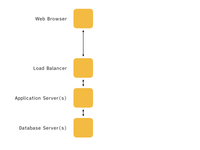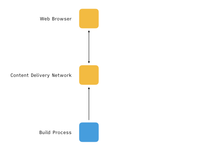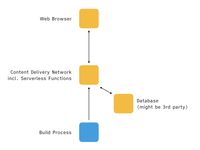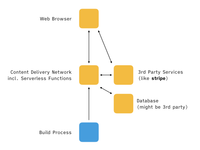Jamstack in 20 minutes
The Jamstack comes with the promise to make websites faster, more secure, and to provide a better developer experience. Why is that the case?
The Jamstack1 can bring huge advantages to the process of building websites, as well as to the way these websites are carried out to users. A Jamstack site
- is fast (probably nothing can be faster than a Jamstack site),
- can run on any infrastructure and a variety of hosting services,
- scales up well,
- is more secure,
- allows deployments with confidence,
- provides an improved developer experience.
Jamstack stands for JavaScript, API, and Markup. Those elements are part of any website, how can a Jamstack site be different from a traditional site that is powered by an web application server?
A traditional architecture would consist of a database, web application servers to carry out the application logic, a load balancer, and web browser clients.

The Jamstack will eliminate the web application server and the load balancer by prerendering the contents of the website, which results in static HTML files (the Markup), CSS, JavaScript, and data files, like XML and JSON. In other words, the Jamstack takes data from various sources and transfers that data into static files. Those static files are stored on a file system which allows to move that content to a Content Delivery Network (CDN) with ease.
A Content Delivery Network is a global network of servers where you can deploy your application to get it closer to users. Without a CDN, If you have a server in London, and you deploy your application on that server, your users in London will have a great experience. That's because the server is close to them so the request-to-response trip is short, hence giving them a very fast experience.
However, that is not the case for your users in other parts of the world farther from London. This is the problem that CDNs solve. Hosting providers like AWS, Azure, Netlify etc have CDNs scattered all over the world. This means that if your site is deployed on their platform, they will respond to your user's requests from the CDN closest to them. Giving everyone the same fast experience, irrespective of their location.
A CDN is not a must for the Jamstack – you can use your own servers – but CDNs are made to deliver static files across the globe and therefore in many cases it makes sense to use them.

The repeat-interval of the prerendering, also named building, depends on the nature of the information carried out to users. It might be multiple times per hour, daily, weekly, once a month, or less.
Dynamic reaction to user input will be achieved by JavaScript (the J of the Jamstack) running on the web browser, progressively enhanced by calling microservices on the server (that´s your API).
Your services have to run on a server, how is that different from a web application server? Jamstack services run as serverless functions on the infrastructure of your CDN provider, like AWS, Azure, Cloudflare, or Netlify. Of course, there is a server, but you don´t have to deal with it, you don´t have to maintain it, you will not patch it, you will not take care of scaling, and the developers don´t recognize it. All the operations are done by the provider. Because providers are focusing on those aspects they can do that most likely better than you can. In my view, when you want to leverage serverless functions you have reached the point where you should rely on a CDN provider, and not host the site by yourself.

It´s not all about your own serverless functions. You can call services written by others. E.g., to perform the payment during checkout of a shopping basket, a 3rd party payment service like stripe could be integrated.

Let´s go into details to see how the Jamstack can live up to the promised benefits.
Performance
The contents served to users are static files that can be handed over extremely fast, as there is no need anymore to evaluate logic for each user request by a web application server. It´s a low number millisecond thing. The CDN will take care of hosting the static files across the globe.
To give an example, after Smashing Magazine moved away from five different technical platforms (including WordPress) to the Jamstack with the Netlify CDN2, their time to first load went down from 800ms to 80ms – a factor of 10! Smashing Magazine had 2.5 million visits each month (80,000 each day) at the time of running the project.
Loblaw, Canada´s largest food retailer with 2,800 stores nationwide, where 85% of canadians shop at at least once a week, is another great example. Justin Watts, Engineering Director at Loblaw Digital, points out in his talk What got us here, won’t get us there that by moving to the Jamstack for one of their core businesses, Shop like a mother, they recognized extreme website improvements:3
- 17.5x faster contentful paint (from 12.3s down to 0.7s), and
- 9.4x faster time to interactive.
Using Netlify for their operations resulted in
- 10x reduction in time to market,
- 38k monthly cost savings,
- fewer attack vectors,
- a happier team.
Portability
Static files can be hosted almost anywhere and on any platform. You wouldn´t have an issue here. A different story is the use of serverless functions. You depend on how your provider offers serverless functions, which would require adjustment in case you want to change your provider and that might not be a small task. In fact, serverless functions create a tight coupling with your CDN provider.4
Scaling
Serving of static files is easy to scale, and the CDN will do that for you. Your provider will also scale up your serverless functions, which is more difficult to do but you will not recognize that.
An excellent example of how well a Jamstack site scales is the United States COVID Tracking Project which was co-founded by Erin Kissane.
In late February 2020 the US Federal Centers for Disease Control (CDC) stopped sharing the total number of COVID-19 tests while the CDC kept publishing the number of positive tests. Without knowing the total number of tests it’s impossible to discern the percentage of infected people at a point in time (the positivity rate). That´s how the COVID Tracking Project started life: As a private initiative of volunteers gathering COVID data for deeper insights into the pandemic (e.g. to know the positivity rate).
The COVID Tracking project became an invaluable resource for citizens, journalists, and even state governments looking for COVID data. What started as a Google Sheet became within three months a Jamstack site able to handle two million requests each day. Erin Kissane explains in her talk The COVID Tracking Project: 0 to 2M API Requests in 3 Months on the Jamstack Conf 2020 how the project team achieved to set up a super fast and super stable website. Their site is hosted by Netlify and built with Gatsby. The data resides in Google Sheets and Contentful. One day, after the White House cited the COVID Tracking Project, the traffic went from 250,000 requests a day up to 1,500,000 requests within 24 hours and there was no slow down or any technical issues with the website. The admins even didn´t notice the rise of traffic!5
Security
Attacks on the web try to post something into the system and get it run inside of your infrastructure (application server, database). A CDN, when serving static files, does not process requests similar to a web application server and therefore has a reduced surface for attackers.
A Jamstack site will connect to services, but when these are managed by specialist third parties, security gaps should be much better under control (stripe payments would not be in the business anymore with an insecure service). But it´s clear, at the moment when services are within the system you should be concerned about security.
Deployments with confidence
It´s hard to overemphasize the benefit of atomic deployments. A deployment with the Jamstack follows the pattern:
- Develop a feature for your site locally
- Build the static contents on the developer machine locally
- Run the automatic tests locally
- If no failures occurred, commit the changes of your source code – not the output of your build – into Git. You might want to ensure successful testing with a Git pre-commit hook.
- Push your Git content to make it available to the CDN. You might have a previous step to push to your test environment.
- The provider will build the static contents
- The provider will run the automatic tests
- If no failure occurred, your site goes online. If a failure occured, no deployment will take place and instead the previous version of your site will remain online.
Two important things here:
- If a failure occurred during building and testing, your new version of the site will not go online and the previous version will remain active. This is called atomic deploys. You do not have to take care of deploying different versions of services separately onto a web application server. The entire site goes online or it doesn´t. This will improve your team´s confidence in deployments.
- Because every step of changing your site is under Git control, you can step to any version of your website within a second.
Developer Experience
Serverless functions are liberating developers. It´s a fast and comfy way of providing server functionality for a website (thumbs up 👍 if you are not confused by the talking about server functionality provided through serverless functions). Tools like netlify-cli allow to run serverless functions on the local environments of the developers.
The building of the static artifacts works well on a developer machine in the sense that every developer will build the complete files of the website on his/her machine, and the file output can be served with a local http server on the developer machine by issuing a single command.
As the build output is static HTML, the developer needs to know HTML. The skills to work with semantic HTML will never be outdated. HTML is a building block of the world wide web and learning how to write HTML is a good investment for any developer who is making websites.6
If you build pages with the idea that parts other than HTML are optional, you’ll create a better and stronger web page.
JavaScript can be used for the building of the static artifacts on the server and on the local dev environment. 11ty is an excellent tool for the task. JavaScript will also be used to add interaction to the HTML pages. Having the same language for the frontend and the backend allows developers to use the same paradigms and toolings, and they can move more easily between the front and the back.
Progressive Web Apps
A Progressive Web App (PWA) will work without a Jamstack and vice versa – it´s two concepts that can stand each on their own. But, static artifacts, when delivered to the web browser, can nicely be injected into a PWA, where the browser will cache those artifacts under the control of a service worker. This will speed up the application once more, and, depending on your use case, will even make it offline-capable. The message is: The Jamstack and PWAs allow for excellent pairing.
Let´s have a look at what a PWA is. I think of a PWA as: You can have an app (cross-platform, mobile and desktop) without the need of visiting an app store.
To quote Aaron Gustafson, Accessibility Strategist at Microsoft:
PWAs start with a great web experience and then enhance that experience for performance, resilience, installation, and engagement.
Have a look at MishiPay´s Scan and Go app, which empowers shoppers to scan and pay for their shopping with their smartphones, rather than wasting time queuing at the checkout.
MishiPay had a problem: Users want to understand the value that an application gives them before they download it. In a store, where MishiPay saves shoppers time and improves their experience, it is counterintuitive for users to wait for a download of a native app before they can use the application. The hassle of downloading an Android or iOS application made users not choose MishiPay´s native apps despite the value. It was a growing challenge for MishiPay. They wanted to increase user adoption with a lower barrier of entry and decided to implement their app as a PWA. This change increased their transactions by a factor of 10. As of March 2022, the majority of transactions ran through their PWA:7
- iOS: 3.98%
- Android: 3.34%
- Web/PWA: 92.68%
The low entry barrier of a PWA, combined with the user experience being close to a native app, makes many well known brands like Starbucks and Spotify implementing their web/app presences as PWAs.
Conclusion
The Jamstack allows to build websites that are fast, robust, scale well, and are a joy to work with for both, users and developers. In my view it´s the most current approach to deliver content on the web. The Jamstack might not be suitable for every case, but if it fits to your problem you cannot do wrong by choosing it.
jamstack.org, an overview site from netlify, who are among the strong advocates of the Jamstack. ↩︎
How Smashing Magazine Manages Content: Migration From WordPress To Jamstack ↩︎
Loblaw Digital, Launching sites and campaigns in minutes with no-ops. ↩︎
Facing the Unplanned Migration of Serverless Applications: A Study on Portability Problems, Solutions, and Dead Ends, by Vladimir Yussupov, Uwe Breitenbücher, Frank Leymann, Christian Müller, December 2019 ↩︎
How The COVID Tracking Project Scaled From 0 to 2M API Requests in 3 Months ↩︎
resilientwebdesign.com by Jeremy Keith is an excellent resource to understand how a website should be built with layers in the order HTML, CSS, JavaScript. At a side note, Resilient Web Design is an offline-capable Progressive Web App. ↩︎
MishiPay's PWA increases transactions 10 times and saves 2.5 years of queuing ↩︎